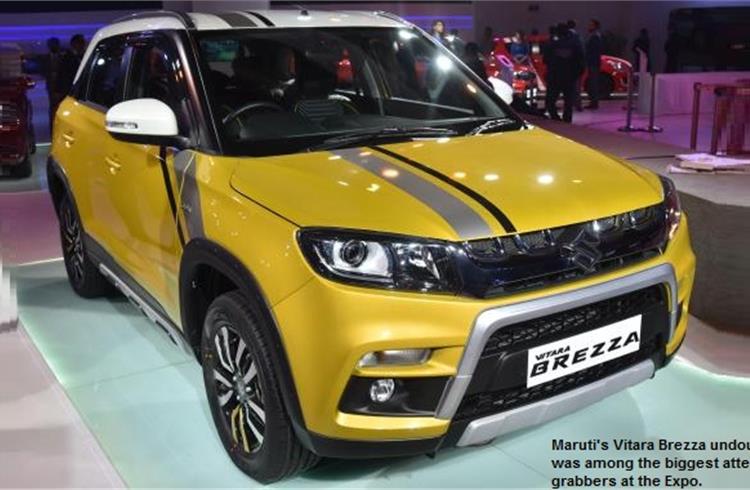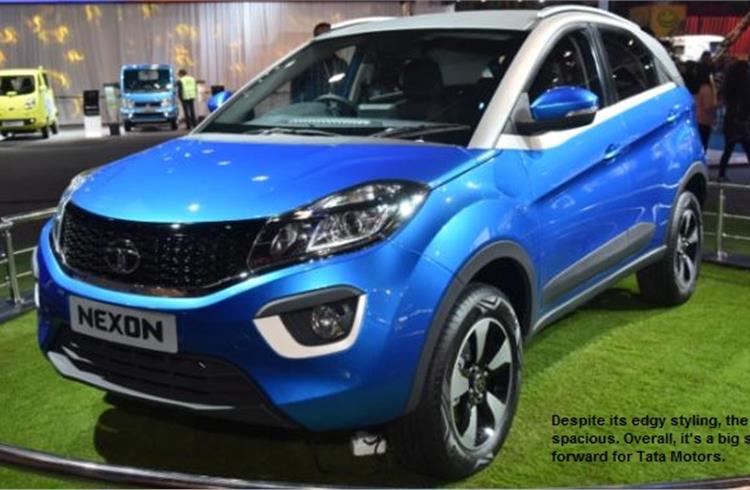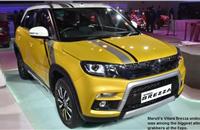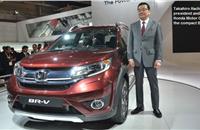Compact segment grows big as OEMs think small
Sensing a huge opportunity in the compact SUV and sedan market, both Indian and foreign vehicle manufacturers have gone for the kill by offering more for less in the sub-four-metre segment.
The 13th Auto Expo 2016 was the biggest ever and as hordes of automotive enthusiasts queued up to get a glimpse of their favourite machines on display at the India Expo Mart in Greater Noida, manufacturers too did not disappoint as they showcased the crème-de-la-crème of what they will offer in the Indian market in the near future.
The expo was officially open for the public from February 5-9 and saw nearly 602,000 visitors, the highest ever in its history. All auto shows have something that is memorable and this year, there were those moments aplenty. Most of the big-ticket announcements happened on the media days on February 3-4. With press meetings held virtually every 15 minutes (the first was at 8am), journos were on their toes and despite the odd incidents of undesirables jostling with each other for freebies inside the press kits, things moved on largely uninterrupted and smoothly.
Here’s a breakdown of what we think were the major highlights of India’s biggest automobile fair.
COMPACT SUVs & CROSSOVERS HOG THE LIMELIGHT
The sub-four-metre segment, which is hugely attractive to OEMs, thanks to the excise duty relief it provides, has attracted the who’s who of the automotive world. Over the past few years, it has been the driver of the sedan and, more recently, the SUV, segment. This segment, comprising both compact sedans and compact SUVs, accounts for almost 16 percent of India’s total passenger vehicle market. Nearly 315,000 vehicles were sold in this category between April-December 2015.
Compact SUVs are riding this growth curve and sensing a good opportunity, most manufacturers have geared up with their own versions. The Auto Expo was the perfect platform to showcase these new entrants and Maruti Suzuki, Tata Motors and Mahindra & Mahindra led the compact SUV charge on the home front.
Tata Motors surprised one and all with the production-ready version of the Nexon compact SUV. With its edgy design yet practical and spacious interiors, the Nexon was, hands down, amongst the best looking cars at the expo this year. The quality and design of the Nexon highlighted the big step up for Tata Motors as an Indian carmaker and provided a glimpse into the company’s approach for the coming years.
Home-grown peer Mahindra & Mahindra showcased Korean subsidiary SsangYong’s Tivoli, its most successful SUV in recent times. With its likely launch around October this year, the Tivoli grabbed plenty of eyeballs due to its sharp styling and sporty interiors.
The biggest crowd puller though was always going to be Maruti Suzuki because of its sheer dominance in this country. And the manufacturer took the opportunity to use the very first press conference of the Auto Expo to unveil perhaps the biggest star of the show at eight in the morning.
The VitaraBrezza is a compact SUV that’s Maruti’s first dig at the sub-four-metre SUV segment, built on a existing global platform from Suzuki. Targeted at customers looking to scale up from the hatchback segment, which is Maruti’s forte, the VitaraBrezza reflects the change in attitude for the country’s largest carmaker, which is now looking to expand to bigger segments and not just be a mass market player.
Maruti also unveiled the Baleno RS, with a sporty bodykit and Suzuki’s 1.0-litre Boosterjet engine and an all-new platform car in the guise of the Ignis. Powering the Ignis will be a 1.3-litre MultiJet diesel engine and a 1.2-litre VTVT petrol engine. Both cars are slated to hit the market around Diwali this year, under the premium Nexa sales channel.
Honda Cars India also joined the compact SUV bandwagon with the much-awaited BR-V. Based on the same platform as the Amaze sedan and the Mobilio MPV, the BR-V is Honda’s answer to the explosion of the sub-four-metre segment in India. Honda, however, has been careful to brand it a ‘crossover utility vehicle’ or CUV, rather than an all-out SUV. It will enter Indian showrooms later this year and will be made at Honda’s Tapukara plant in Rajasthan with production expected to begin in April this year.
After the big success of the Creta in India, Hyundai also unveiled a compact-SUV concept. The HND-14 is under four metres long and will lead to a production version in the future, one that in all probability will go on sale in 2017.
TRUE-BLUE SUVs SHOW OFF
Indian roads, which are currently populated by small low-cost cars, may witness a change of character given the prominent role of SUVs at this year’s Auto Expo. Even as compact SUVs were the flavour this time around, their over-4-metre siblings weren’t too far behind either.
The biggest news for full-grown SUV aficionados in India came with arrival of the iconic Jeep brand. The SUV maker showcased two of its halo models—the Wrangler Unlimited and the Grand Cherokee SRT. The Wrangler Unlimited is the longer wheelbase model of the legendary SUV, powered by a 197bhp 2.8-litre diesel engine mated to a five-speed automatic gearbox.
The Grand Cherokee SRT is the most luxurious performance-oriented offering from the SUV maker’s stable. Introducing Jeep’s Street & Racing Technology performance division in India, this sporty SUV swaps the 3.0-litre diesel engine on the Grand Cherokee for a more potent 6.4-litre HEMI V8 petrol engine. It pumps out a humungous 461bhp and a thundering 63.6kgm of torque, which translates to a 0-100kph time of 5 seconds.
Also on display was the Grand Cherokee. The model that is India-bound – the Summit variant – comes with a long equipment list. It gets a panoramic sunroof, 20-inch chrome alloy wheels, bi-xenon adaptive headlamps heated and ventilated seats, sat-nav, Bluetooth connectivity, parking sensors, reversing camera, an electric tailgate, and two USB slots for those in the rear seat. Under the hood, there’s a 3.0-litre V6 diesel motor churning out 237bhp and mated to an eight-speed ZF gearbox.
The Wrangler Unlimited, Grand Cherokee, and the Grand Cherokee SRT are set to go on sale in mid-2016 in India, with the first dealerships in the metros, followed by Tier 1 cities.

Mahindra & Mahindra showcased its own top-of-the-line XUV Aero coupé-SUV concept. M&M’s interesting take on the segment features a suicide door on one side and shares styling elements with the XUV 500. The prototype has been built by Italian design firm Pininfarina (recently acquired by M&M) and styled in-house by the carmaker.
While officially a concept, Mahindra has hinted that this could make it to production depending on feedback from the public. The coupé-SUV segment in India currently only has models from major luxury brands like Mercedes-Benz and BMW with the GLE Coupé and the X6, respectively. With the aggressively styled XUV Aero concept, Mahindra seems to be considering an entry into this niche segment.
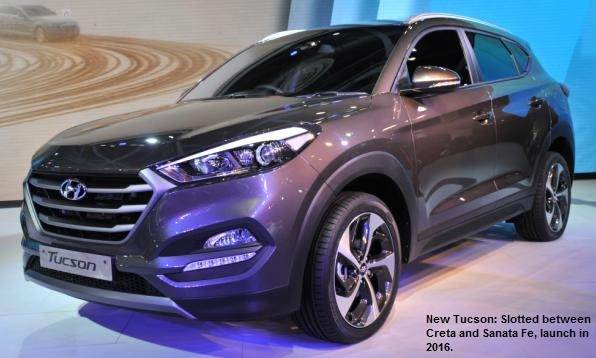
Hyundai Motor India showcased the Tucson, its only SUV not on sale in the country yet. Sitting between the popular Creta and the luxurious Santa Fe, the Tucson will complete Hyundai’s SUV range in India. Currently in its third generation, the new car was shown at the Geneva Motor Show in 2015 first and features an attractive design language familiar to latest Hyundai vehicles.
Mercedes-Benz unveiled its C-class-based SUV – the GLC. Slotted between the GLA and GLE, the GLC is a rival to the BMW X3 and the Audi Q5, a segment in which Mercedes was absent so far in India. The SUV combines the luxurious interiors of the C-class with the tall seating and space of an SUV. Not only is the GLC taller than the sedan, but it also features a longer wheelbase. However, the GLC is more of a soft-roader than an out-and-out off-roader.
The Stuttgart-based luxury carmaker also had a surprise in store for AMG SUV enthusiasts, in the form of the G 500 4×4². ‘The mother of all SUVs’, as it was nicknamed, stands two metres tall and is nearly as wide. Its imposing height comes from the car’s 450mm ground clearance, a result of the portal axles incorporated on the SUV.
The G 500 4×4² is powered by a twin-turbocharged, 4.0-litre V8 – a unit similar to the one found in the recently launched AMG GT S. With a power output of 410bhp, the engine propels the super-SUV to a claimed top speed of 208kph. Still in the concept phase, the production plans for the SUV are not known yet, but it definitely contributed to the zing at the Expo.

The increase in SUV sales has triggered a general decline in the MPV market globally, but the Toyota Innova remains a huge success story in India, and the latest-generation InnovaCrysta drew much attention at the Toyota stall, becoming one of the most popular cars at the show.
The differences between the current Innova and the new one are immediately apparent and the styling is a huge step up from the current model. The fascia is clearly influenced by recent models like the Toyota Corolla Altis and the new Camry. The Crysta receives a 45bhp bump in power compared to the current Innova, thanks to an all-new 147bhp, 2.4-litre GD series engine that replaces the current 102bhp, 2.5-litre KD series unit. It will also feature an all-new 2.8-litre diesel motor and another 2.7-litre petrol engine as well.
Tata Motors also showcased the production-ready version of the Hexa. Based on the same platform as the Aria, the Hexa is Tata’s bet for a strong footing in the SUV-crossover segment in India and could peg it right against the Innova. The Hexa looks like another testament to Tata’s new design philosophy and grabbed plenty of eyeballs at the expo.
FEW NEW HATCHES BUT COMPACT SEDANS COMPENSATE
The biggest surprise, or rather shock, at the Expo this time around was the dearth of any new hatchbacks apart from the Tata Zica. This changing scenario was clearly visible in products showcased by manufacturers and apart from a few crossovers there weren’t even any major hatchback concepts on display either.

The enthusiasm surrounding the Zica too was marred as the entire marketing campaign was hit by the news that Tata was set to rename the car because of its association with the Zika virus.
A couple of interesting concepts in the hatchback segment were seen at the Renault pavilion, as the French carmaker revealed two cars based on the game-changing Kwid hatchback: the Climber and Racer. The Climber is an off-road concept to illustrate the potential for the Kwid’s all-terrain ability, while the Racer previews a performance-focused version with 18-inch alloys, an Alcantara, aluminium and carbon interior, bucket seats, and improved aerodynamics. Neither is expected to result in a production version, but features from both could end up in future models.
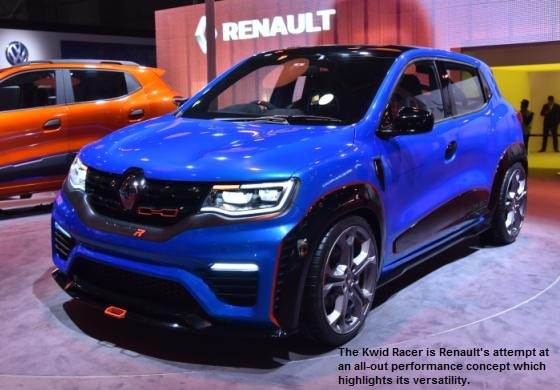
Compact sedan lovers though had something to cheer for in the form of the Volkswagen Ameo. The sub-four-metre car, which has been designed and engineered for the Indian market and manufactured at the company’s plant in Chakan, Maharashtra, will see its official launch in the second half of
2016. The Ameo will be available with both petrol and diesel engine options – a 73bhp, 1.2-litre, three-cylinder MPI and an 89bhp, 1.5-litre, four-cylinder TDI engine from the Polo.
Tata Motors too displayed its fresh take at the compact sedan segment in the form of the Kite 5. The sub-four-metre compact sedan shares its mechanicals and styling with the Zica hatchback, and the additional boot being the only differentiator. The Kite 5 derives power from the same 1.2-litre, three-cylinder petrol engine and the 1.05-litre, three-cylinder diesel motors offered on the hatchback.
Chevrolet too unveiled an all-new compact sedan concept called Beat Essentia and announced that the production version will be launched in the Indian market in 2017.
THE GREEN SCENE
With growing pollution levels in India in the spotlight recently, and many people calling on the passenger vehicle industry to do its bit and more, manufacturers showcased some of their hybrid and electric technologies. However, despite the growing concerns, there wasn’t much to talk about when it came to actual production models based on alternate fuels and electrics at this year’s Expo. All one could see were smatterings of eco-friendly options, like a racing concept based on the Mahindra e20 Reva, Volkswagen’s Passat GTE and Nissan’s X-Trail Hybrid.

The fact that hybrid technology remains a rarity in the country, and the EV infrastructure is inadequate to say the least, was again testified by almost non-existent presence of these vehicles at the Auto Expo 2016.
Nevertheless, with much more stringent emission norms (BS VI) all set to be implemented by 2020 as a result of India leapfrogging BS V standards, the country has embarked upon the path for a cleaner and greener future. While green and alternative fuel vehicles will take some time to make it to the mainstream, expect carmakers in India to ramp up their electric and alternate-fuel capabilities. The forthcoming Union Budget 2016-17 just might have some additional incentives that could help accelerate the process.
For the complete review, read Autocar Professional’s February 15, 2016 – Auto Expo Review issue
RELATED ARTICLES
Branded content: HL Klemove inaugurates first Local ADAS Radar Manufacturing Unit in India, marks a significant achievement in “Make in India” initiative
The inauguration ceremony was held in the presence of Vinod Sahay, President and CPO of Mahindra & Mahindra Ltd. and Dr....
BluWheelz to 'Green Up' logistics sector
With their EVs-as-a-service solution, the startup is playing it smart with costs and looking to electrify the entire seg...
BRANDED CONTENT: Spearheading the EV revolution in India
Jio-bp is a joint venture between Reliance Industries and BP PLC where both entities have married international expertis...





 By Shourya Harwani
By Shourya Harwani
 19 Feb 2016
19 Feb 2016
 6748 Views
6748 Views



